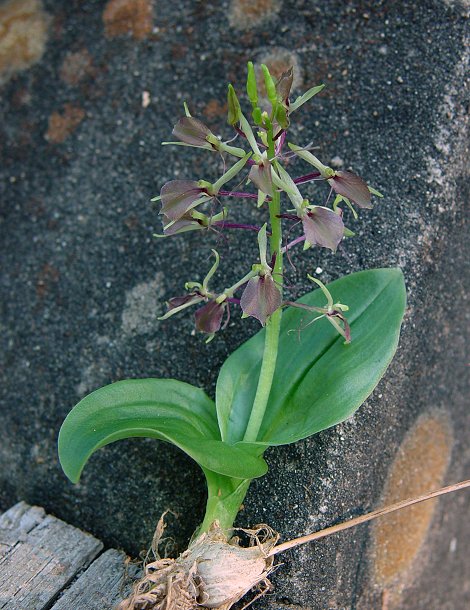Liparis liliifolia (L.) Rich. ex Lindl.
Large Twayblade

Native
CC = 7
CW = 3
MOC = 52
© SRTurner
Liparis liliifolia (L.) Rich. ex Lindl.Large Twayblade | |
 |
Native CC = 7 CW = 3 MOC = 52 |
© SRTurner |
|
Family - Orchidaceae Habit - Plants with bulblike corms.
Stems - Erect, to 30 cm, herbaceous, glabrous, green, from a bulblike corm and thickened roots. Corm surrounded by a papery sheath with a reticulate pattern (easiest to see when dry). Leaves - Basal, sheathing, 2-3 per plant, glabrous, entire, shiny-green above, lighter abaxially, to 15 cm long, 8 cm broad, broadly elliptic to ovate, rounded at the apex.
Inflorescence - Terminal raceme of 5-30 flowers to 8 cm tall. Axis glabrous.
Flowers - Sepals 3, 9-12mm long, yellow-green, spreading, all similar, narrowly oblong to narrowly lanceolate, with revolute margins and appearing folded, glabrous. Lateral petals purplish, pendant or spreading, linear, to 1.3 cm long. Lip arching downward, to 1.2cm long, purplish-green but darker purple at the base abaxially, glabrous, expanded, obovate, abruptly acute at the apex. Column 3-4 mm long, arching over the lip, green. Stamen 1, staminodes lacking.
Fruits - Capsules ascending, 15-18 mm long, oblanceolate in outline, the ribs winged, the stalks as long or longer than the capsules.
Flowering - May - June. Habitat - Dry to mesic upland woods, streambanks, slopes, ridgetops, on acidic substrates. Origin - Native to the U.S. Lookalikes - L. loeselii. Other info. - This striking little species can be found throughout much of Missouri, though it is rare or absent in much of the western third of the state. Beyond Missouri its range extends eastward and northward. The plant can be identified by its large, shiny, ground-level leaves and dull purplish inflorescence. It is easily overlooked because the inflorescence tends to blend in visually with underlying leaf litter. The closely related L. loeselii is similar but has smaller flowers with a yellow-green lip. This latter species is much less common in Missouri and is only found in a handful of Ozark counties. Photographs taken in the Ozark Scenic Riverways, 6-9-03 (DETenaglia); also at Sandy Creek Covered Bridge Historical Site, Jefferson County, MO, 8-22-2016; and at St. Joe State Park, St. Francois County, MO, 6-2-2025 (SRturner). |